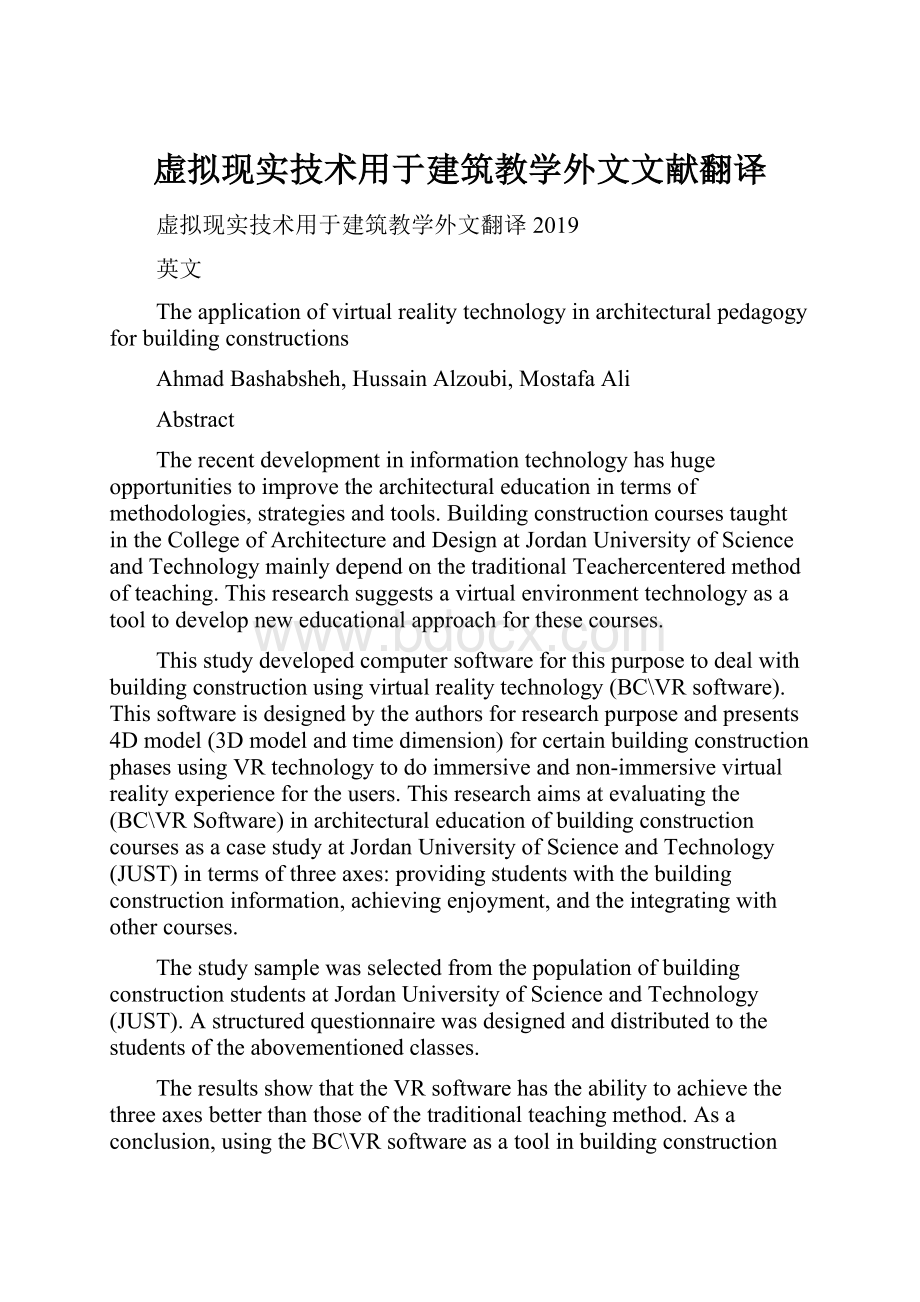虚拟现实技术用于建筑教学外文文献翻译.docx
《虚拟现实技术用于建筑教学外文文献翻译.docx》由会员分享,可在线阅读,更多相关《虚拟现实技术用于建筑教学外文文献翻译.docx(12页珍藏版)》请在冰豆网上搜索。

虚拟现实技术用于建筑教学外文文献翻译
虚拟现实技术用于建筑教学外文翻译2019
英文
Theapplicationofvirtualrealitytechnologyinarchitecturalpedagogyforbuildingconstructions
AhmadBashabsheh,HussainAlzoubi,MostafaAli
Abstract
Therecentdevelopmentininformationtechnologyhashugeopportunitiestoimprovethearchitecturaleducationintermsofmethodologies,strategiesandtools.BuildingconstructioncoursestaughtintheCollegeofArchitectureandDesignatJordanUniversityofScienceandTechnologymainlydependonthetraditionalTeachercenteredmethodofteaching.Thisresearchsuggestsavirtualenvironmenttechnologyasatooltodevelopneweducationalapproachforthesecourses.
Thisstudydevelopedcomputersoftwareforthispurposetodealwithbuildingconstructionusingvirtualrealitytechnology(BC\VRsoftware).Thissoftwareisdesignedbytheauthorsforresearchpurposeandpresents4Dmodel(3Dmodelandtimedimension)forcertainbuildingconstructionphasesusingVRtechnologytodoimmersiveandnon-immersivevirtualrealityexperiencefortheusers.Thisresearchaimsatevaluatingthe(BC\VRSoftware)inarchitecturaleducationofbuildingconstructioncoursesasacasestudyatJordanUniversityofScienceandTechnology(JUST)intermsofthreeaxes:
providingstudentswiththebuildingconstructioninformation,achievingenjoyment,andtheintegratingwithothercourses.
ThestudysamplewasselectedfromthepopulationofbuildingconstructionstudentsatJordanUniversityofScienceandTechnology(JUST).Astructuredquestionnairewasdesignedanddistributedtothestudentsoftheabovementionedclasses.
TheresultsshowthattheVRsoftwarehastheabilitytoachievethethreeaxesbetterthanthoseofthetraditionalteachingmethod.Asaconclusion,usingtheBC\VRsoftwareasatoolinbuildingconstructioncoursesisveryusefulandeffectiveforthestudents.TheVRtechnologyisalsoapplicableonotherarchitecturalcourses.
Keywords:
Buildingconstruction,Architecturaleducation,Virtualreality,VRtechnology
1. Introduction
Withtheevolutionofinformationandcommunicationtechnology,changeandimprovementbecomeveryessentialinmanysectors.Educationsectorconsidersinformationandcommunicationtechnologyasoneofthemostimportanttoolstodeveloplearningprocess.
Becauseofthegreatdevelopmentinbuildingconstructionindustry,aswellasthecomplexityoftheprojectsdesignandforms,itisimportanttodevelopthearchitecturalengineeringeducationusingmultimediasuchas,immersivevirtualreality,videos,andsimulationtechnologies.
Virtualrealitytechnology(VR)andinteractionby3Dgeometricmodelcouldbringanendtothepassivelearningwhichisfollowedinthetraditionalmethodologyofeducation.Theyalsoleadtobeneficialcommunicationbetweenvariousparticipantsineducationprocess.
Buildingconstruction(BC)coursesofferedintheacademiccurriculaatarchitecturedepartmentsarestilltaughtusingthetraditionalways;mainly,byteachercenteredlearningway.Basically,studentsrelyonwhatteachersgiveorteachinsidetheclassroom.Thismethodologyofteachingmakesunderstandingideassoboringandlessefficientformanystudents;especiallyforstudentswhoarenotinterestedinbuildingconstructioncourses.
Withtheevolutionininformationtechnology,multimedia,andthedevelopmentinvirtualenvironmentgivetheopportunityfordevelopingtheeducationalprocessinbuildingconstructioncoursesandusingmoreeffectivewaysandmethodsofteachingotherthanthetraditionalones.Thiswillmakebuildingconstructionandstructuralideasmoreunderstandable.
Thisresearchfocusesonvirtualenvironmenttobeatoolforneweducationalapproachinarchitecturalfield;mainly,inbuildingconstructioncourses.Itaimsatevaluatingtheapplicationofvirtualrealitytechnologyinarchitecturaleducationasatechniquethatsuppliesnewteachingmethodology,especiallyinbuildingconstruction(BC)courses.Theultimategoalofthisstudyisachievedbyfulfillingthefollowingobjectives:
1.EvaluatingtheabilityofstudentstogaininformationbyusingVRtechnologycomparedwiththatofthetraditionalwayofteaching.
2.EvaluatingtheenjoymentlevelforstudentsinlearningbyusingVRtechnologycomparedwiththatofthetraditionalwayofteaching.
3.EvaluatingtheintegrationwithotherteachingcoursesbyusingVRtechnologycomparedwiththatofthetraditionalwayofteaching.
Totesttheabovementionedhypotheses;theauthorsdesignedanddeveloped(BC/VRsoftware)containsallphasesofbuildingconstructionofaselectedbuildingwithasetoffeaturesforusersshowingallphasesofbuildingconstructionsetinsequentialstepswiththeabilitytowalkthrougheachphaseinvirtualimmersiveandnon-immersiveenvironment.Eachphaseisattachedtoimportantdocumentsandvideostoexplaintheconstructionprocessineachphase.Thissoftwarecontainsallarchitecture,structural,detaileddrawingsoftheproject.
TheBC/VRsoftwarehasbeenexperimentedandusedfortestingthestudentsofbuildingconstructioncoursesJordanUniversityofScienceandTechnology(JUST)inthedepartmentofarchitectureasacasestudy.
2. Educationalthoughts
Thisresearchpresentsthearchitecturalpedagogyasathoroughunderstandingofteachingmethodsthatreflecttheadvancementofnewtechnology.
Mortimer(1999)definespedagogyas“anyconsciousactivitybypersontoenhancethelearningofanother.”Pedagogyisapersonalissue;itistheartofscienceofteachingwhichincludesprinciplestoimprovelearning.
Ingeneral,educationalscienceconsistsofmethods,Teachingtechniques,Educationalenvironment-tool,andEducationalPsychology-MultipleIntelligences.
Educationalmethodsareclassifiedto“student-oriented”and“teacher-oriented”whichincludenarratinglecture,discussion,askingquestions,Samplecase,showingsample,problemsolving.
2.1. Learner-centeredmethodology
NormanandSpohrer(1996)distinguishbetweenlearner-centeredandteacher-centeredmethods.Inthefirstmethod,studentsareactiveparticipantsinthelearningprocessratherthanpassiverecipients.Inthesecondmethod,studentsarelikeemptyvesselsneedtobefilled.Inthisapproachthereisafocusontheimportanceofstudentsinprocessingknowledgeasco-constructorsofknowledge.
3. Virtualrealityforeducation
VirtualReality(VR)technologyemergedin1980swiththedevelopingofsystemincludingHeadMountedDisplay(HMD)anddatasuitconnectedtoacomputer.Thesetechnologiesimitated3Denvironmentsurroundedbymaterializedorstereoscopicview.
Although“ThetermVRwasfirstusedin1980s”,thedevelopmentoftheVRstartedmuchearlierwithoutanysinglespecificdateforitsinvention.However,therearemajorhallmarksinitsdevelopmentduringthetimelinefrom1916untilnow.In1929AsimplemechanicalflightsimulatorwasdevelopedbyEdwardLinkforpilottrainingatastationary.In1956MortonHeiligdevelopedamultimodalexperiencedisplaysystemcalledSensoramaandwaspatentedin1960.
Inthe1970s,computergraphicsweregreatlyimprovedbySutherlandandhisstudentswhoexploredtherenderingof3Dobjects.
Thefirstinteractivearchitecturalwalkthroughsystemwasdevelopedbetween1970and1985”,attheUniversityofNorthCarolina(UNC)andthiscontinuedtoberefinedinamajorresearchprogram(Brooks,1986,1992)”.
In1984,theNASAAerospaceHumanFactorsResearchDivisioncreatedtheVirtualInterfaceEnvironmentWorkstation(VIEW)labbyScottFisher.
ManyVRcompaniessuchVPL,LEEPSystemreceivedearlyfundingtoworkwiththeVIEWlab.VPLcreatedtheDataGlovein1985andIPhonesinwhichahead-mountedstereodisplayedin1989.
Otherhead-baseddisplaysweredesignedfortheVIEWproject;forinstance,theoriginalBOOMhead-baseddisplaydesignedin1987byJimHumphries,leadengineerfortheNASAVIEWproject.
HowardRheingold1991 definesvirtualreality(VR)as“anexperienceinwhichapersonissurroundedbyathreedimensionalcomputer-generatedrepresentation,andisabletomovearoundinthevirtualworldandseeitfromdifferentangles,toreachintoit,grabit,andreshapeit.”.Bertol(1997)describesVRas“acomputer-generatedworldinvolvingoneormorehumansensesandgeneratedinreal-timebytheparticipant’sactions.”
3.1. Virtualrealitysystems
Virtualrealitysystemssupporttimeandlocationandconsistofcomputers,users,hardwareandsoftware.(Whyte)dividedVirtualrealitysystemsintotwomaincategories:
ImmersiveVirtualandNonimmersive.
3.1.1. Immersivesystems
Immersivesystemstotallysurroundtheusers,theydothisthroughspecifichardwareandneedhigh-endcomputingpower.Immersivevirtualrealitysystemsisreplacedwithheadmounteddisplayunit.
3.1.2. Non-immersivesystems
Inthissystem,theviewerssupposedlyarenottotallyimmersedusingmoregenerichardware.Itisaswindow-on-a-worldsystemsinwhichthevirtualrealitycanbeseenthroughdisplayscreen.
3.2. VRineducation
Virtuallearningenvironmentintegratesthetraditionalwayofeducationbybringingtherealworldintotheclassroom.Accordingtothedevelopmentincommunication,simulation,andthewayofpresentinginformation,VRhasbeenbroadlyusedtotrainhighriskoccupationanddisciplinessuchaspilottraining.However,VReducationalpurposesinconstructionhavebeenlimited.
Walker,1990 suggestedthatputtingusersinathreedimensionalexperiencemakesthemfeelliketheyareinsideavirtualworldratherthanjustobservingimages.So,VRtechnologyisagoodtoolforapplyinginconstructivistapproachinlearninginwhichitprovidesuserswithrealexperienceinanyeducationalenvironment.
4. Fourdimension